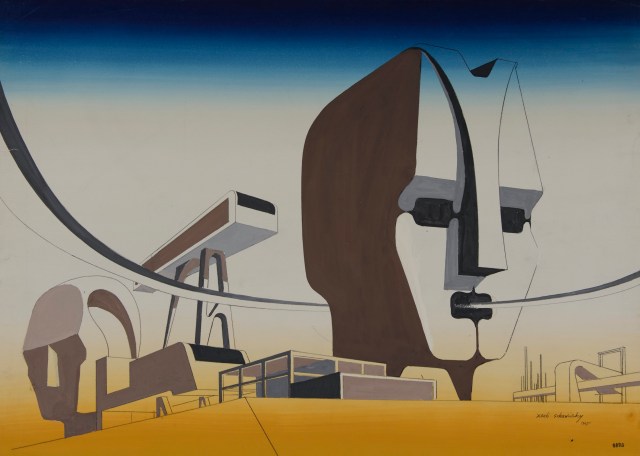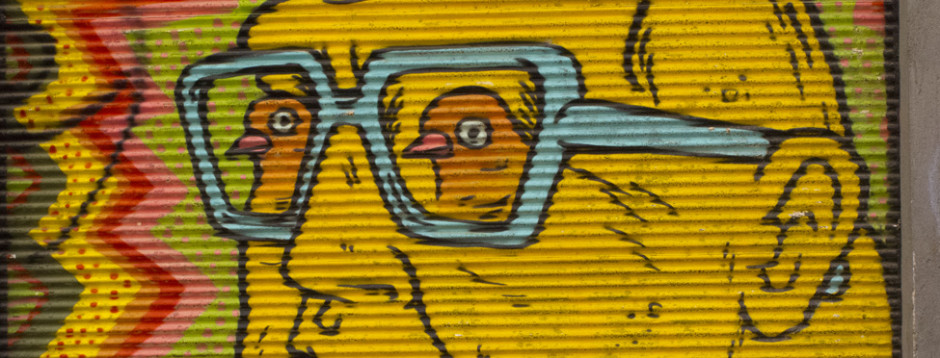October 17, 2014 in Hyperallergic

Xanti Schawinsky, “The Aviator (Faces of War)” (1942), mixed media, watercolor and black pen on paper, 28 7/8 x 21 inches (73.4 X 53.4 cm) (all works courtesy of and copyright the Xanti Schawinsky Estate, unless otherwise noted)
The Drawing Center has mounted a strange and surreal show of drawings by Xanti Schawinsky, an underrated artist whose 50-plus-year career spanned the 1920s to the late ’70s. Celebrating a peripatetic artist who worked in photography, avant-garde theater, graphic design, jazz, painting, and product design, this show presents a small but concentrated portion of of Schawinsky’s oeuvre.

A view of two works, “The Home Guard (Faces of War)” (1942) and “The General (Faces of War)” (1942), in The Drawing Center exhibition.
Schawinsky lived a life that could have been a film script. Here’s the synopsis: Born in 1904, he was the child of Polish Jews, raised in Switzerland. In 1924, he moved to Germany and became a beloved and vital member of the Bauhaus, working mostly in theater, graphic design, and jazz. He fled pre-war Germany to Italy where he became an important graphic and advertising artist. He immigrated to the United States in 1936, settling at Black Mountain College along with Bauhaus colleagues Josef and Anni Albers. He taught there for two years and then hit New York City for a career in commercial art and to pursue his passion for painting amidst a close-knit European expat community. Schawinsky revisited his experimental work in theater, photography, and drawing, while teaching at various universities in NYC. He eventually moved back to Italy, where he lived until his death in 1979. His was a life that spanned much of the 20th century.

Xanti Schawinsky, “Jewelry Head” (1941–44) from the Head Drawings series, graphite on paper, 30 1/2 x 22 1/2 inches (77.5 X 57.2 cm), Norman Waitt Jr. Collection
The show, entitled Head Drawings and Faces of War, juxtaposes two very different bodies of work, each portraying the same object: the human head. The Head Drawings, pencil on plain paper, are very formal, beautifully rendered exercises in composition. In each, Schawinsky has taken a collection of objects — jewelry, plants, rope, for example — and assembled the disparate parts into drawings of the human head. It’s a bit like the old art school assignment to take an object and draw it 50 ways. In one, Schawinsky creates the most minimal and modern of heads, constructed out of the building blocks, geometric planes, cones, and orbs. In another, a woman’s hand dripping with Baroque jewelry is outstretched in empty space. Several of the ornate pendants hanging off of her laden hand create a woman’s face. These do not appear to be portraits of anyone. They are in fact cool, almost academic. Inventive and clever, they are admirable displays of old-fashioned draftsmanship.
Xanti Schawinsky, “The Warrior (Faces of War)” (1942), mixed media, watercolor and black pen on paper, 29 x 21 3/8 inches (73.7 X 54.2 cm) (All works courtesy of and copyright the Xanti Schawinsky Estate, unless otherwise noted)
However, what makes them, and the exhibition, so powerful is the juxtaposition of these “cool” heads with the Faces of War, which “face” them in the elegant Drawing Center installation.
The Faces of War are also perfectly rendered drawings, although of a very different “head.” These heads, floating in gently gradient fields of color, are constructed out of the detritus of war. Like science fiction visions of the future they each stand alone, as if in a series of advertisements, each showing off “this year’s model.” One such head rolls through a rosy pink field, on tank treads, its eyes and nose are guns trained to shoot. Another in the form of a parachute floats in the air — a deadly machine with eyes locked and loaded. The gentle calm and sublime color selection of the backgrounds— indigo, melting into yellow, blue gracefully changing to orange — belies the brutal nature of the machine like “war” heads. Schwinsky’s strict Bauhaus graphic design training is most evident here. The subject matter is bizarre, surreal, and political; the melding of death machine into the human form and intellect. But the work’s design mastery renders them oddly all the more terrifying. It’s the holding back, the control, the sense of purpose that fills these drawings with such dread.

Xanti Schawinsky, “Architectural Design” (1945), mixed media, watercolor and black pen on paper, 20 3/4 x 28 7/8 inches (52.7 X 73.4 cm)
The Drawing Center’s juxtaposition of these two bodies of work captures the heightened sense of anxiety, creative tension, and deeper psychology that haunts Schawinsky’s noncommercial work. Although he left Europe before the outbreak of WWll, the experience observed from afar was seared into his artistic consciousness. At the same time that he was making these cool pencil “head” drawings that give nothing away, he was making “war” images, which betray a deep-seated sense of despair and anxiety. It’s this duality — “everything’s fine” on one hand, and on the other a portrait of mankind at its worst — that makes the atmosphere of surreality so poignant.

Xanti Schawinsky, “Euclidian” (1943), Head Drawings, graphite on paper, 31 1/2 x 23 inches (80 X 58.4 cm)
Do these works portray Allies or fascists? It doesn’t matter. In the world of Xanti Schawinsky, it’s all the same. If the Head Drawings are optimistic about the infinite creative possibilities of man, then the Faces of War are their pessimistic counterbalance. If we are infinitely creative, we are also infinitively destructive.
Xanti Schawinsky: Head Drawings and Faces of War continues until December 14 at the Drawing Center (35 Wooster Street, Soho, Manhattan).

Thank you for alerting your readers to this wonderful collection of drawings. Your very thoughtful comments helped me to see subtlety in the drawings that I overlooked.
It really does help to have a serious and articulate artist as a guide to other people’s work. It is good of you to do this.
Thank you for your kind and thoughtful response! Much appreciated!( and thanks for reading the blog)